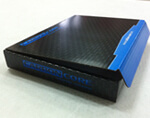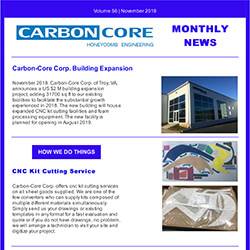In the transportation industry, weight savings equal cost savings: Either increase power or decrease engine size or weight, which in turn decreases pollution.
 The transportation industry, in general, is a source of noise pollution which can only be tackled by materials offering good acoustical properties with respect to both noise and vibration dampening, such as CarbonCore Plastic Honeycomb.
The transportation industry, in general, is a source of noise pollution which can only be tackled by materials offering good acoustical properties with respect to both noise and vibration dampening, such as CarbonCore Plastic Honeycomb.- Whether for private or public transportation applications, CarbonCore Plastic Honeycomb offers multiple solutions; for example in industrial vehicle bodies (bus floor and wall, truck floor and sleeper cab) or for fitting out specific types of vehicles such as ambulances, mobile telecommunications centers, or professional race cars, just to name a few.
- For the high volume automotive industry, with its demand for competitive pricing, CarbonCore fulfills its need. When combined with glass fiber reinforced thermoplastics, CarbonCore enables large dimensioned parts to be made like floors or trunk load floors as well as shelving units, in one single operation. This results in lower tool and die equipment setup costs.
Sandwich construction has been well established in the composites industry for well over 60 years.
Industrial designers specify sandwich construction for much the same reason architects use I-BEAMS and trusses: to increase stiffness and strength while at the same time decrease weight. The honeycomb core in a sandwich laminate acts much the same as the web in the I-BEAM by connecting the load bearing skins. The increase in stiffness is directly related to the height of the web (or thickness of the core).
Due to the fact that some earlier boats used either inadequate building methods or the wrong core material for the engineered load, sandwich construction is often debated. However, these isolated incidents are not the rule and most sandwich constructed boats have performed well over the years.
Famed composites pioneer Mr. K. Brandl writes: “The main function of the core material is to distribute local loads and stresses over large areas. Local stresses applied to one side of the sandwich have only a reduced local effect because the exposed skin and the core will distribute the loads to a larger area of sandwich.”
Because of this, a sandwich structure generally exhibits superior behavior under bending, torsion, impact and compression, parallel or perpendicular to the skins. Besides its function of a spacer and connecting unit between the skins, a core material for boat building must therefore exhibit enough resilience to absorb impact stresses. Its ability to cushion and absorb shocks in alternating stresses and torsion loads, passing from skin into the core, as they occur in a boat under practical conditions, is a necessary requirement of the core. Such dynamic stresses as well as impacts, should the core not be resilient, can result in severe damage and eventual destruction of the entire structure. A boat or ship should, with all required stability and homogenous stiffness, not be an inflexible structure. It should be a mechanically stabilized structure, which still allows movements within the elastic range of its materials. It should further exhibit the characteristic to withstand short-term overloading without destruction and lasting damage. Generally, one can encounter unexpected loads and stresses by two alternatives. One is to design to such a limit that the structure will in every case be many times stronger than the unexpected loads, i.e., the structure would have to be over-engineered and be overweight. A more advanced engineering concept is to counter the unexpected loads by a structure, which, having sufficient mechanical strength and stiffness, is still in a position to withstand peak loads without damage of serious consequences to the structure. In order to realize this concept, a rigid elastic structure is a prerequisite design criteria.
The advantages of sandwich construction are numerous:
IMPACT STRENGTH
A sandwich construction using honeycomb core with its high degree of resiliency is more impact resistant than a single skin laminate with equal or higher weight. The increase in impact strength, as compared to single skin laminates is better demonstrated if one sees the core as a shock absorber that evenly supports the outside skin from impacts and protects the inside skin, while still having enough elasticity to maintain the bond line between the core and the skins. Experience shows that although sandwich conduction is not completely puncture proof it significantly increases skin penetrating puncture resistance. The more brittle cross-linked PVC and SAN foams would simply crumble and shear under a severe impact, whereas polypropylene honeycomb cored structures would be locally damaged, however the core structure would be intact and cells, although elongated would still keep their structure and shape, ready to absorb or withstand more impacts and compression.
COST & WEIGHT
Weight affects different modes of transportation in a different way. For instance, in sailboats, extra weight does not automatically translate into higher operating cost, but affects performance. In full displacement type sailboats cored hulls can aid in insulation lowering cooling/heating costs. In power boats up to 20′ in length, the effects of sandwich construction can be marginal, as weight advantages can be achieved by alternate means. But as the boats get bigger the weight becomes increasingly more important, as the weight translates directly into extra cost of pushing the extra mass and the initial extra cost of sandwich construction is quickly overcome. As the weight get lighter, boats will get improved range, need less power, can carry more cargo or people and need less tankage, thus improving interior space. Therefore the cost of the sandwiched boat, when compared to the single skin solid laminate boat, becomes a very cost-effective approach at over long term operating expenses.
VIBRATION DAMPING/SOUND ATTENUATION
With it’s natural harmonic of 125-150 HZ polypropylene is known for it’s vibration damping/noise absorption properties. Almost all of our customers, after switching from a different core material, have notified us that they have noticed a significant change in boats being quieter. Noise and vibration travel well through a single skin laminate. Boats with cored hulls are simply quieter. Balsa wood and brittle foams transfer noise energy directly through the laminate. Polypropylene and some more elastic foams dampen the noise energy due to their plastic nature.
THERMAL INSULATION
Thermal insulation in vessels must be considered: as most often the boat sits in water much colder than the ambient temperature, consideration forms, leaving the vessel stained and allows the mildew to form. Sandwich construction significantly aids in eliminating the condensation and associated bilge water. The cored insulating layer coincidentally eliminates the need for highly flammable spray-in polyurethane.
THE CLUB SANDWICH
In large composite structure , club sandwich approach, where a single extra layer of fiberglass is added between the two layers of core, is often utilized. This is one of the most effective ways to utilize the properties of polypropylene honeycombs since due to its nature. honeycomb shear properties are reduced when thickness of the core is increased beyond a certain limit. By utilizing two thinner layers of honeycomb versus one thick layer of honeycomb, one will significantly increase the overall performance of the laminate. Additionally, even when the outside skin is punctured or ripped, the middle and Inside skins will remain intact, and the vessel will most certainly maintain its watertight ability.
Design Guidelines
Shear Properties
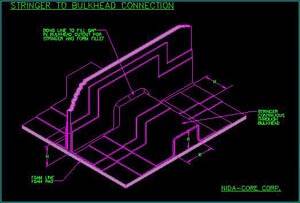 Shear strength is used as one of the input factors to determine the sandwich laminate thickness. However, laboratory tests of shear properties do not do justice for some of the materials, primarily honeycomb. ASTM and ISO test standards for testing for shear strength specify the sample size; essentially a thin strip of material that is then loaded on a relatively short span and measured. Honeycomb structures are disadvantaged in thin strips, since the cell structure is broken along the edges when the sample coupons are cut from a panel. Furthermore, strength values may often be sited without indication of deflection or elongation. High shear strength may be recorded for low elongations, which may necessitate over-designed skin laminates to assure that small deflections will not induce “Core Shear Failure” and consequently catastrophic structural failure. Conversely, low shear strength may be recorded for high elongations, corresponding to deflections that could not be sustained by other design factors or limitations of the laminates, such that this low shear material would never fail in shear. Full scale structures must be evaluated as a whole, and increasingly large panel performance and shear elongation are a critical consideration. This is particularly true when considering honeycomb sandwich laminates. In early 1960s and 1970s, a lot of boats were built with an early version of PVC linear foam, with comparatively low shear strength. Several of these boats are still in service and have been obviously very successful designs.
Shear strength is used as one of the input factors to determine the sandwich laminate thickness. However, laboratory tests of shear properties do not do justice for some of the materials, primarily honeycomb. ASTM and ISO test standards for testing for shear strength specify the sample size; essentially a thin strip of material that is then loaded on a relatively short span and measured. Honeycomb structures are disadvantaged in thin strips, since the cell structure is broken along the edges when the sample coupons are cut from a panel. Furthermore, strength values may often be sited without indication of deflection or elongation. High shear strength may be recorded for low elongations, which may necessitate over-designed skin laminates to assure that small deflections will not induce “Core Shear Failure” and consequently catastrophic structural failure. Conversely, low shear strength may be recorded for high elongations, corresponding to deflections that could not be sustained by other design factors or limitations of the laminates, such that this low shear material would never fail in shear. Full scale structures must be evaluated as a whole, and increasingly large panel performance and shear elongation are a critical consideration. This is particularly true when considering honeycomb sandwich laminates. In early 1960s and 1970s, a lot of boats were built with an early version of PVC linear foam, with comparatively low shear strength. Several of these boats are still in service and have been obviously very successful designs.
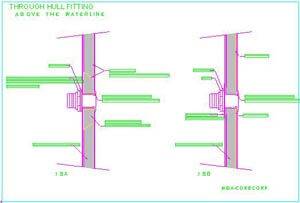 Any presumption that shear strength is the key design parameter is simply not true. While many composite professionals may have built airplane models with balsa before learning about fiberglass, it was logical to start with a rigid base and laminate to it. Conversely, to apply high performance laminates on either side of a compliant material is counter-intuitive. But the current generation of young airplane model builders is actually using fiberglass strapping tape over the surfaces of expanded polypropylene foam. Build time is reduced, but most importantly the sample CAD drawing virtually indestructible nature of the resulting structure has provided a far more satisfying product. Likewise, when designing structures using polypropylene honeycombs, one must remember that there is a significant difference in the value of the stress and strain at yield than there is at shear ultimate. Polypropylene honeycomb can stretch and carry loads without failure after the yield point, so that the value at ultimate shear is still higher than at yield. It must also be reminded that the basis of many design specifications pre-date the common of multi-axial stitched reinforcements, which are generally higher in strength but not as thick, and therefore have given up some flexural stiffness. However, when used with sandwich construction to provide the required cross section for flexural stiffness, multi-axial stitched reinforcements are ideally suited for sandwich construction, achieving further weight reductions compared with previous laminations.
Any presumption that shear strength is the key design parameter is simply not true. While many composite professionals may have built airplane models with balsa before learning about fiberglass, it was logical to start with a rigid base and laminate to it. Conversely, to apply high performance laminates on either side of a compliant material is counter-intuitive. But the current generation of young airplane model builders is actually using fiberglass strapping tape over the surfaces of expanded polypropylene foam. Build time is reduced, but most importantly the sample CAD drawing virtually indestructible nature of the resulting structure has provided a far more satisfying product. Likewise, when designing structures using polypropylene honeycombs, one must remember that there is a significant difference in the value of the stress and strain at yield than there is at shear ultimate. Polypropylene honeycomb can stretch and carry loads without failure after the yield point, so that the value at ultimate shear is still higher than at yield. It must also be reminded that the basis of many design specifications pre-date the common of multi-axial stitched reinforcements, which are generally higher in strength but not as thick, and therefore have given up some flexural stiffness. However, when used with sandwich construction to provide the required cross section for flexural stiffness, multi-axial stitched reinforcements are ideally suited for sandwich construction, achieving further weight reductions compared with previous laminations.
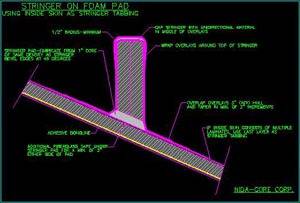 Furthermore, since the increased strength of multi-axial stitched reinforcements is achieved at greater strains, CarbonCore Plastic Honeycomb is increasingly selected as the most appropriate core sample CAD drawing material. A thorough designer must therefore consider the most important test for core materials – shear strain in %, or shear elongation after the yield point (ISO 1922) which most accurately determines the degree of toughness for a specific core. It is not important whether one uses the shear yield or shear ultimate value in design, what is important that based on these figures, appropriate safety factors are built in. For polypropylene honeycomb one can design much higher up the elastic curve because the factor of safety is in the balance of the elastic range of the curve, and then in shear elongation after yield. We are not saying here that successful designs can not be made with cross-linked PVC or balsawood, with inherently low shear elongation factors, simply the shear stress must be in the lower portion of the curve and not too close to the yield. However, even the balance of the elastic range of the curve is seldom sufficient under severe impacts. Primary focus should be stiffness, while at the same time ensuring there is an adequate safety margin to fall back on. If the structure is stiff enough, the stresses are usually low. However, stiffness without damage tolerance is not a desirable criterion. Several different sources have been used to obtain criteria for composites boat construction. Some are adaptations of wood designs with interchangeable single skin fiberglass equivalent. Several criteria is derived from equivalent designs using metallic materials , primarily aluminum. This criteria seems to work well with some older types of core materials but are lacking when it comes to NEW core materials such as polypropylene honeycomb, especially when thinner skins are used. Most design criteria lacks in areas where stresses beyond normal loads are applied.
Furthermore, since the increased strength of multi-axial stitched reinforcements is achieved at greater strains, CarbonCore Plastic Honeycomb is increasingly selected as the most appropriate core sample CAD drawing material. A thorough designer must therefore consider the most important test for core materials – shear strain in %, or shear elongation after the yield point (ISO 1922) which most accurately determines the degree of toughness for a specific core. It is not important whether one uses the shear yield or shear ultimate value in design, what is important that based on these figures, appropriate safety factors are built in. For polypropylene honeycomb one can design much higher up the elastic curve because the factor of safety is in the balance of the elastic range of the curve, and then in shear elongation after yield. We are not saying here that successful designs can not be made with cross-linked PVC or balsawood, with inherently low shear elongation factors, simply the shear stress must be in the lower portion of the curve and not too close to the yield. However, even the balance of the elastic range of the curve is seldom sufficient under severe impacts. Primary focus should be stiffness, while at the same time ensuring there is an adequate safety margin to fall back on. If the structure is stiff enough, the stresses are usually low. However, stiffness without damage tolerance is not a desirable criterion. Several different sources have been used to obtain criteria for composites boat construction. Some are adaptations of wood designs with interchangeable single skin fiberglass equivalent. Several criteria is derived from equivalent designs using metallic materials , primarily aluminum. This criteria seems to work well with some older types of core materials but are lacking when it comes to NEW core materials such as polypropylene honeycomb, especially when thinner skins are used. Most design criteria lacks in areas where stresses beyond normal loads are applied.

